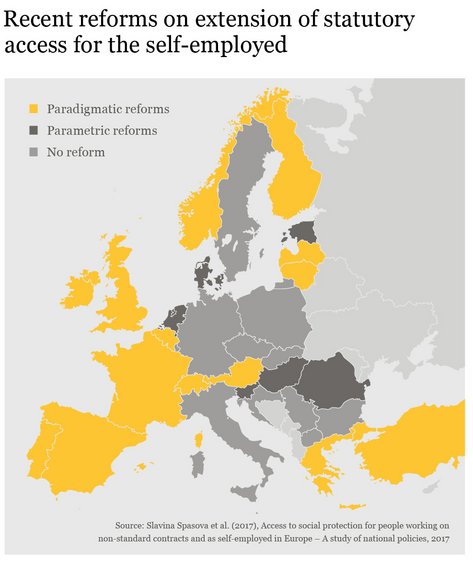
In search of solutions – the Member States
ed* No. 01/2018 – Chapter 5
The way the participants see themselves and the specific structure of the relationships between platform operators, platform users and those who perform the activity lead to new forms of employment models. Therefore, the question arises as to whether social security systems, which are tailored to traditional employment relationships, are still suitable for these new forms or whether they have to be adapted to ensure adequate social protection.
The EU Member States are taking different approaches, which reflect their individual national frameworks, to extend social protection to people in non-standard employment. Attempts are being made to fully integrate workers in non-standard employment, who have had little or no access to social security, into the social security systems.1 An example of this is recalculating contribution periods for part-time employees with respect to social security benefits that are dependent on contributions. In some cases, attempts are also being made to faster convert fixed-term contracts into full-time employment. Another example is the inclusion of self-employed persons, who are financially dependent on a single client, under the labour laws applicable to traditional employment contracts, together with the relevant social security rights.
In order to ensure adequate access to social protection for the self-employed, adjustments are usually made within a system, for example, by changing the calculation base, harmonising contribution rates and changing eligibility conditions, or a more fundamental approach is taken. The latter aims to fully integrate self-employed persons into social security; for example, by establishing a new status for the self-employed or new social benefit schemes for the self-employed. In some Member States, reforms are being done both ways.2
Other interesting approaches are being taken in France and Estonia. In France, the act on financing social security of 2017 gives platform operators the opportunity to submit sales figures instead of the platform worker. In turn, the platform worker can choose whether to follow the social security rules and contributions for self-employed workers or those for workers in standard employment. In the latter case, contributions are based on 40% of turnover (13% for renting out accommodation). Starting in 2018, the current stand-alone system for protecting business owners and freelancers (Régime social des indépendants) will be migrated to the general statutory social insurance system (Sécurité sociale).
Estonia has introduced a ‘business income account’ for the self-employed as part of an act on simplified business income taxation. A person can transfer their business income into this account and is taxed at 20%. This money is then divided between various social security contributions, including health insurance, contributions to the first and second pillars of the pension and income tax. However, this regulation is not mandatory.

Outlook: Do we need a European initiative?
Implementing the European Pillar of Social Rights is a joint obligation and responsibility of the European Union and its Member States. It should be done according to the respective competences of the Union and the Member States. This should take into account the diversity of national systems, including the role of the social partners, and the different socio-economic conditions. This also applies to the recommendation of ensuring adequate social protection for all forms of employment.
The examples mentioned above show that the Member States are fully aware of their responsibility to guarantee adequate social protection for all workers and that they are trying to find solutions to the issue using their national systems. It will be interesting to see which way the EU Commission chooses. The best way forward would be to support the Member States, for example, by helping them to exchange experiences and information about finding national solutions or best practices. This would enable Member States to learn from one another and to keep up with new developments in a rapidly changing world of work so that they can ensure access to adequate social protection for all workers.

